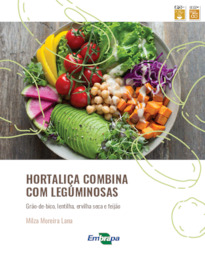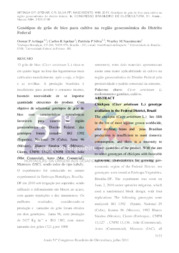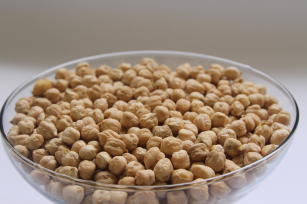Embrapa Agrobiology
 Busca de Notícias
Busca de Notícias
Brazil receives full chickpea collection from India
An agreement between the Brazilian Agricultural Research Corporation (Embrapa) and the International Crops Research Institute for the Semi-arid Tropics , headquartered in India, facilitated importing a full chickpea gene bank (core collection) from said country to integrate the Brazilian collection, which is used in breeding and genetic improvement research to develop new cultivars.
In total, Brazil received over 25 kilos of chickpea seeds, containing 1853 samples that were individually packed in paper envelopes with approximately 100 seeds in each. The material entered the country in late April and, after the processing of the import dossier by inspectors of the Ministry of Agriculture, Livestock and Food Supply (MAPA), it is being quarantined at Embrapa Genetic Resources and Biotechnology, located in Brasília, DF, for plant health analyses and tests, before their clearance for the purposes of agricultural research.
“The transfer of the chickpea seed collection from India to Brazil was facilitated by the International Treaty on Plant Genetic Resources for Food and Agriculture (ITPGRFA), which both countries undersign”, explains the technician Danielle Biscaia, supervisor of the Research Programming Support Team at Embrapa Vegetables (Brasília, DF).
During the quarantine, the plant materials undergo analyses in different laboratories to check the possible presence of mites, insects, weeds, bacteria, fungi, nematodes or viruses. “The analyses aim to intercept quarantine pests (according to the list published by MAPA) and exotic pests that can cause damages to the crop that is being introduced”, explains Norton Polo Benito, a researcher at Embrapa Genetic Resources and Biotechnology.
According to him, the analyses are made directly on the seeds. Part of the seeds are saved for sowing, so that the plant development is followed and new analyses are made in plants with pest symptoms.
Triumph for research
After the quarantine ends, a period that can vary from four to six months, ICRISAT's collection will start to integrate Embrapa's chickpea gene bank, and then it will be crossed with different materials in the scope of the breeding program to obtain new cultivars with traits of interest to the Brazilian production sector.
At Embrapa's gene bank, the samples are conserved in cold chambers, but before that undergo a drying process to reach the recommended humidity of 10%, and then they are placed in moisture-proof aluminum packages. In the cold chamber, they are stored at a temperature from 5 ºC to 10ºC with 40% of relative humidity.
“Having access to a full gene bank from an international research center, with samples collected in different places of the world and with high variability, increases our chances of finding materials with tolerance to pests and diseases or other qualities that are interesting for the context of chickpea production and consumption in the country”, assesses the researcher Warley Nascimento, from Embrapa Vegetables, as he comments that the market has become more demanding and requires precocious and productive cultivars with good agronomic, industrial and nutritional traits.
The chickpea samples will be sown in Brazil's climate and soil conditions to assess their agronomic performance. The specialists estimate that, on average, the research will take five years to be able to assess all the samples received. “Chickpeas are a species that originated in the Asian continent, and thus, when we sow the samples here, everything will be new and different from the behavior observed there. It is important to perform an assessment in Brazilian conditions and thus ensure the perenniality of research on chickpeas in our country”, signals Nascilento, who was in India in a visit to ICRISAT when discussions about receiving the collection started.
New cultivars and export possibilities
There are two fronts of work with the new chickpea samples in Embrapa's germplasm collection: in the short term, after testing the materials in Brazilian conditions, if any of them fully adapts well, it can be made available as a new cultivar; and in the medium term, the new samples will be inserted in the breeding program, in crossings with other cultivars previously developed by Embrapa, such as BRS Aleppo, with the aim of obtaining cultivars with superior characteristics..
According to the researcher, all their traits will be considered throughout the study, but there will be a bigger focus on materials that are tolerant to the pulse pod borer, a concerning chickpea pest; materials that better withstand water deficit and drought conditions, to position the grain for off season cropping and semiarid regions; and materials with high protein content that facilitate processing as plant-based food products, a segment that has shown an annual growth of between 10 and 20%.
Moreover, in the research horizon, there is also the possibility of the country becoming a chickpea exporter to the rest of the world. Currently, Embrapa's BRS cultivars are all of the kabuli type, which has a bigger grain biggest and color beige, and are more consumed in the domestic market. “With the new samples in our gene bank, we will be able to extend the research to the desi type of chickpeas, which has small seeds and a brown tone, and is more consumed in other countries. Soon we will expand our research scope with the potential of exports to the international market”, Nascimento concludes.
Paula Rodrigues (MTb 61.403/SP)
Embrapa Vegetables
Press inquiries
hortalicas.imprensa@embrapa.br
Phone number: +55 61 3385-9100
Translation: Mariana Medeiros (13044/DF)
General Secretariat
Further information on the topic
Citizen Attention Service (SAC)
www.embrapa.br/contact-us/sac/





